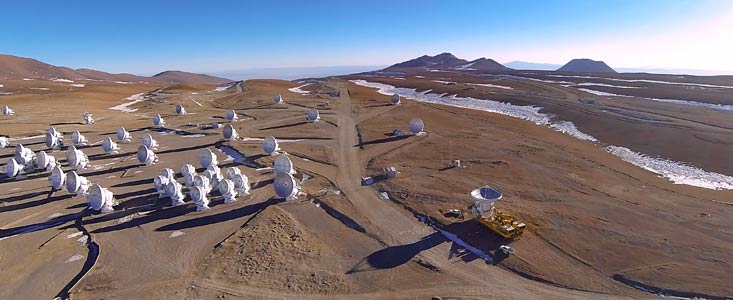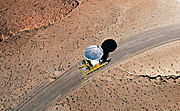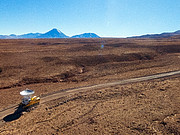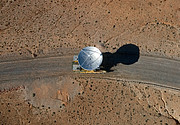Meddelelse
Sidste ALMA-antenne ankommer på Chajnantor-højsletten
16. juni 2014
Den sidste antenne til Atacama Large Millimeter/submillimeter Array (ALMA) projektet er blevet bragt op til ALMA-observatoriet 5000 meter over havets overflade. Dens ankomst fuldender samlingen af 66 ALMA-antenner på Chajnantor-højsletten i Atacama-ørkenen i det nordlige Chile, hvor de i fremtiden vil arbejde sammen som ét stort teleskop.
Den 66. ALMA-antenne er nu blevet transporteret til Array Operations Site (AOS). Den blev leveret til ALMA Observatoriet til afsluttende afprøvning i oktober 2013 (eso1342).
Antennen, der er 12 meter i diameter, er den 25. og sidste europæiske antenne, der er transporteret op til Chajnantor-højsletten. Den vil arbejde ved siden af dens europæiske forgængere, samt 25 nordamerikanske 12-meter-antenner og 16 østasiatiske (fire 12-meter og tolv 7-meter) antenner.
Det globale ALMA samarbejde er det største jordbaserede astronomiske projekt, der findes. Den sidste Europæiske antenne blev fremstillet af det Europæiske AEM Consortium [1], som en del af den hidtil største ESO-kontrakt. Den omfattede design, fremstilling, transport og færdiggørelse på stedet af de 25 antenner.
ALMA-observatoriet blev indviet af Chiles præsident, Sebastián Piñera, ved en højtidelighed i marts 2013. Det markerede færdiggørelsen af alle det gigantiske teleskops større systemer og den formelle overgang fra et konstruktionsprojekt til et fuldt funktionsdygtigt observatorium.
"Dette markerer afslutningen på mange år med levering af state-of-the-art højteknologi-systemer og dele til Chajnantor og er en vigtig milepæl for ALMA-projektet. Alle ALMA-antenner er nu klar til at blive integreret i operationerne," siger Wolfgang Wild, den europæiske ALMA-programleder.
ALMA undersøger Universet ved at studere lys med millimeter- og submillimeter-bølgelængder, der ligger mellem infrarødt lys og radiobølger i det elektromagnetiske spektrum. Lys ved disse bølgelængder kommer fra enorme kolde skyer i rummet mellem stjernerne og fra nogle af de tidligste og fjerneste galakser i Universet. Teleskopet vil give astronomer et vindue til det mystiske kolde Univers, hvor hemmeligheder om vores kosmiske oprindelse venter på at blive opdaget.
Noter
[1] AEM-konsortiet er sammensat af Thales Alenia Space, European Industrial Engineering og MT-Mechatronics.
Mere Information
ALMA, en international astronomifacilitet, er et partnerskab mellem Europa, Nordamerika og Østasien i samarbejde med Chile. Konstruktionen og driften af ALMA ledes i Europa af ESO, i Nordamerika af National Radio Astronomy Observatory (NRAO) og i Østasien af National Astronomical Observatory of Japan (NAOJ). Joint ALMA Observatory (JAO) står for den samlede ledelse og overordnede styring af konstruktionen, ibrugtagningen og driften af ALMA.
ESO er den mest fremtrædende internationale astronomi-organisation i Europa og verdens mest produktive astronomiske observatorium. ESO har i dag følgende 15 medlemslande: Belgien, Brasilien, Danmark, Finland, Frankrig, Holland, Italien, Portugal, Schweiz og Storbritannien, Spanien, Sverige, Tjekkiet, Tyskland og Østrig. ESOs aktiviteter er fokuseret på design, konstruktion og drift af jordbaserede observationsfaciliteter for at muliggøre vigtige videnskabelige opdagelser inden for astronomi. ESO spiller også en ledende rolle for at fremme og organisere samarbejdet inden for astronomisk forskning. I Chile driver ESO tre unikke observatorier i verdensklasse: La Silla, Paranal og Chajnantor. På Paranal driver ESO Very Large Telescope (VLT), der er verdens mest avancerede astronomiske observatorium til observationer i synligt lys samt to kortlægningsteleskoper. VISTA arbejder i infrarødt lys og er verdens største kortlægningsteleskop, mens VLT Survey Telescope (VST) er det største teleskop, der udelukkende er bygget til at kortlægge himlen i synligt lys. ESO er den europæiske partner i et revolutionerede astronomisk teleskop kaldet ALMA, det største igangværende astronomiske projekt. ESO planlægger i øjeblikket et 39 meter optisk/nær-infrarødt teleskop kaldet European Extremely Large Telescope (E-ELT), der vil blive "verdens største øje mod himlen".
Links
Om meddelelsen
| Id: | ann14048 |
Our use of Cookies
We use cookies that are essential for accessing our websites and using our services. We also use cookies to analyse, measure and improve our websites’ performance, to enable content sharing via social media and to display media content hosted on third-party platforms.
ESO Cookies Policy
The European Organisation for Astronomical Research in the Southern Hemisphere (ESO) is the pre-eminent intergovernmental science and technology organisation in astronomy. It carries out an ambitious programme focused on the design, construction and operation of powerful ground-based observing facilities for astronomy.
This Cookies Policy is intended to provide clarity by outlining the cookies used on the ESO public websites, their functions, the options you have for controlling them, and the ways you can contact us for additional details.
What are cookies?
Cookies are small pieces of data stored on your device by websites you visit. They serve various purposes, such as remembering login credentials and preferences and enhance your browsing experience.
Categories of cookies we use
Essential cookies (always active): These cookies are strictly necessary for the proper functioning of our website. Without these cookies, the website cannot operate correctly, and certain services, such as logging in or accessing secure areas, may not be available; because they are essential for the website’s operation, they cannot be disabled.
Functional Cookies: These cookies enhance your browsing experience by enabling additional features and personalization, such as remembering your preferences and settings. While not strictly necessary for the website to function, they improve usability and convenience; these cookies are only placed if you provide your consent.
Analytics cookies: These cookies collect information about how visitors interact with our website, such as which pages are visited most often and how users navigate the site. This data helps us improve website performance, optimize content, and enhance the user experience; these cookies are only placed if you provide your consent. We use the following analytics cookies.
Matomo Cookies:
This website uses Matomo (formerly Piwik), an open source software which enables the statistical analysis of website visits. Matomo uses cookies (text files) which are saved on your computer and which allow us to analyze how you use our website. The website user information generated by the cookies will only be saved on the servers of our IT Department. We use this information to analyze www.eso.org visits and to prepare reports on website activities. These data will not be disclosed to third parties.
On behalf of ESO, Matomo will use this information for the purpose of evaluating your use of the website, compiling reports on website activity and providing other services relating to website activity and internet usage.
Matomo cookies settings:
Additional Third-party cookies on ESO websites: some of our pages display content from external providers, e.g. YouTube.
Such third-party services are outside of ESO control and may, at any time, change their terms of service, use of cookies, etc.
YouTube: Some videos on the ESO website are embedded from ESO’s official YouTube channel. We have enabled YouTube’s privacy-enhanced mode, meaning that no cookies are set unless the user actively clicks on the video to play it. Additionally, in this mode, YouTube does not store any personally identifiable cookie data for embedded video playbacks. For more details, please refer to YouTube’s embedding videos information page.
Cookies can also be classified based on the following elements.
Regarding the domain, there are:
- First-party cookies, set by the website you are currently visiting. They are stored by the same domain that you are browsing and are used to enhance your experience on that site;
- Third-party cookies, set by a domain other than the one you are currently visiting.
As for their duration, cookies can be:
- Browser-session cookies, which are deleted when the user closes the browser;
- Stored cookies, which stay on the user's device for a predetermined period of time.
How to manage cookies
Cookie settings: You can modify your cookie choices for the ESO webpages at any time by clicking on the link Cookie settings at the bottom of any page.
In your browser: If you wish to delete cookies or instruct your browser to delete or block cookies by default, please visit the help pages of your browser:
Please be aware that if you delete or decline cookies, certain functionalities of our website may be not be available and your browsing experience may be affected.
You can set most browsers to prevent any cookies being placed on your device, but you may then have to manually adjust some preferences every time you visit a site/page. And some services and functionalities may not work properly at all (e.g. profile logging-in, shop check out).
Updates to the ESO Cookies Policy
The ESO Cookies Policy may be subject to future updates, which will be made available on this page.
Additional information
For any queries related to cookies, please contact: pdprATesoDOTorg.
As ESO public webpages are managed by our Department of Communication, your questions will be dealt with the support of the said Department.






